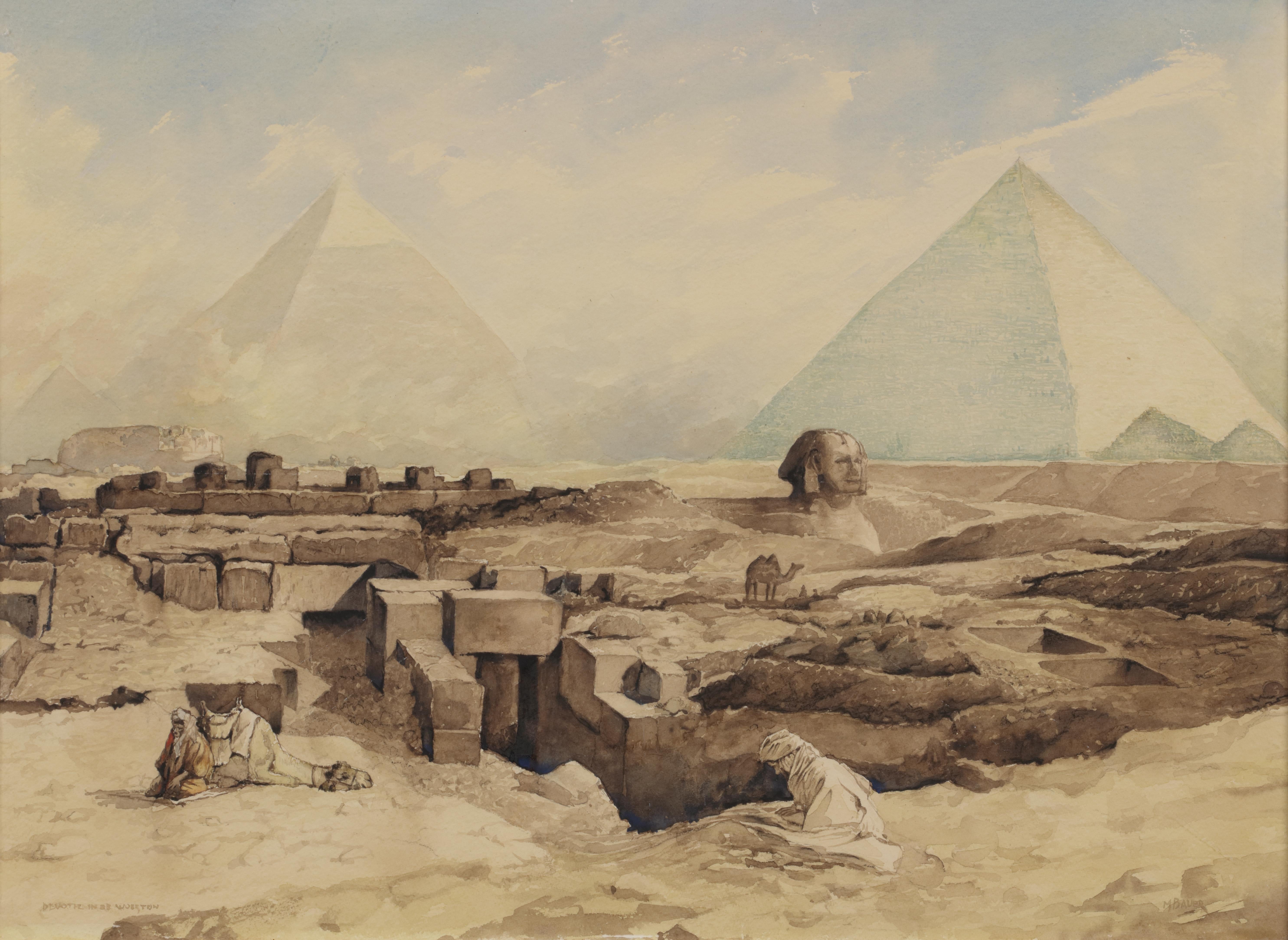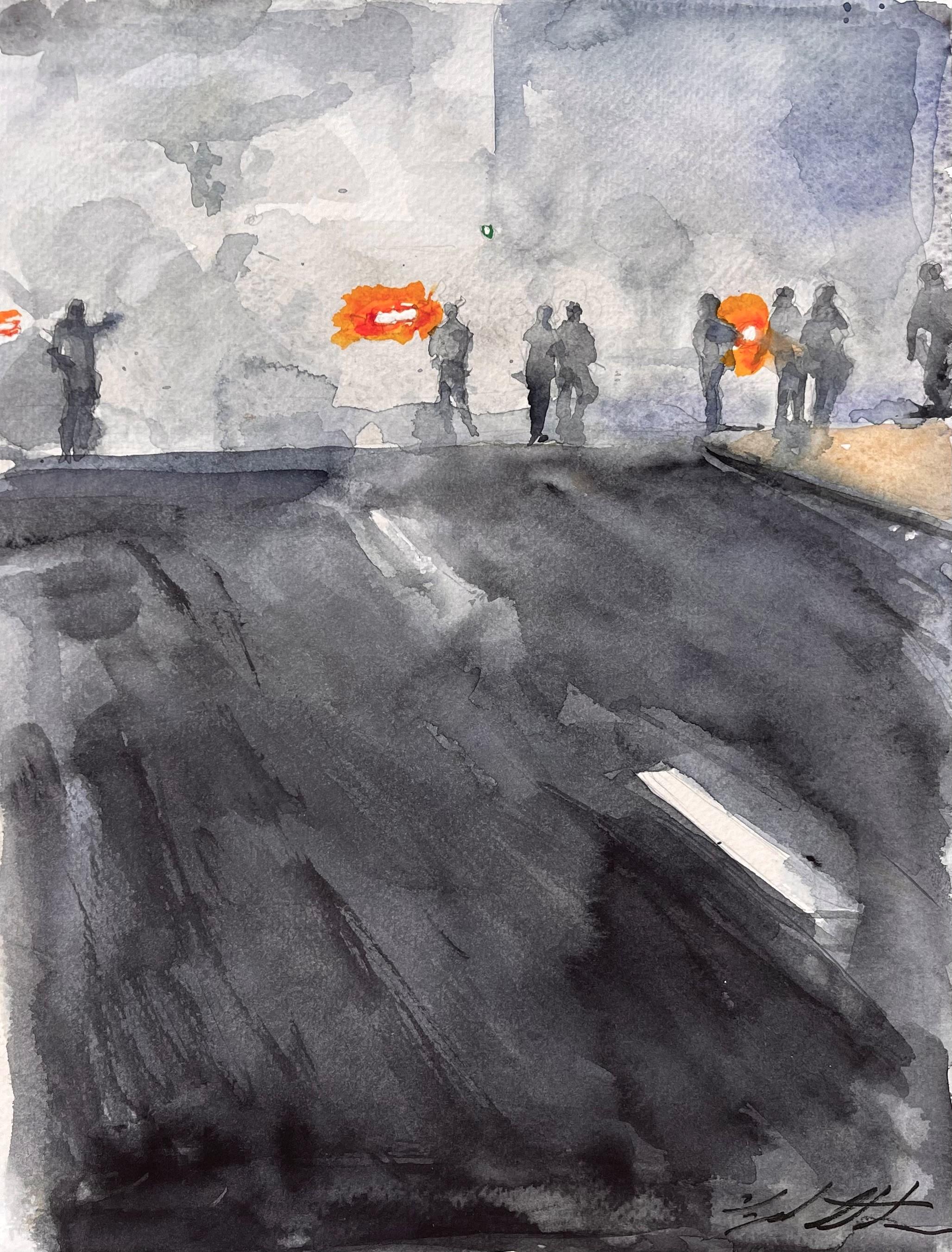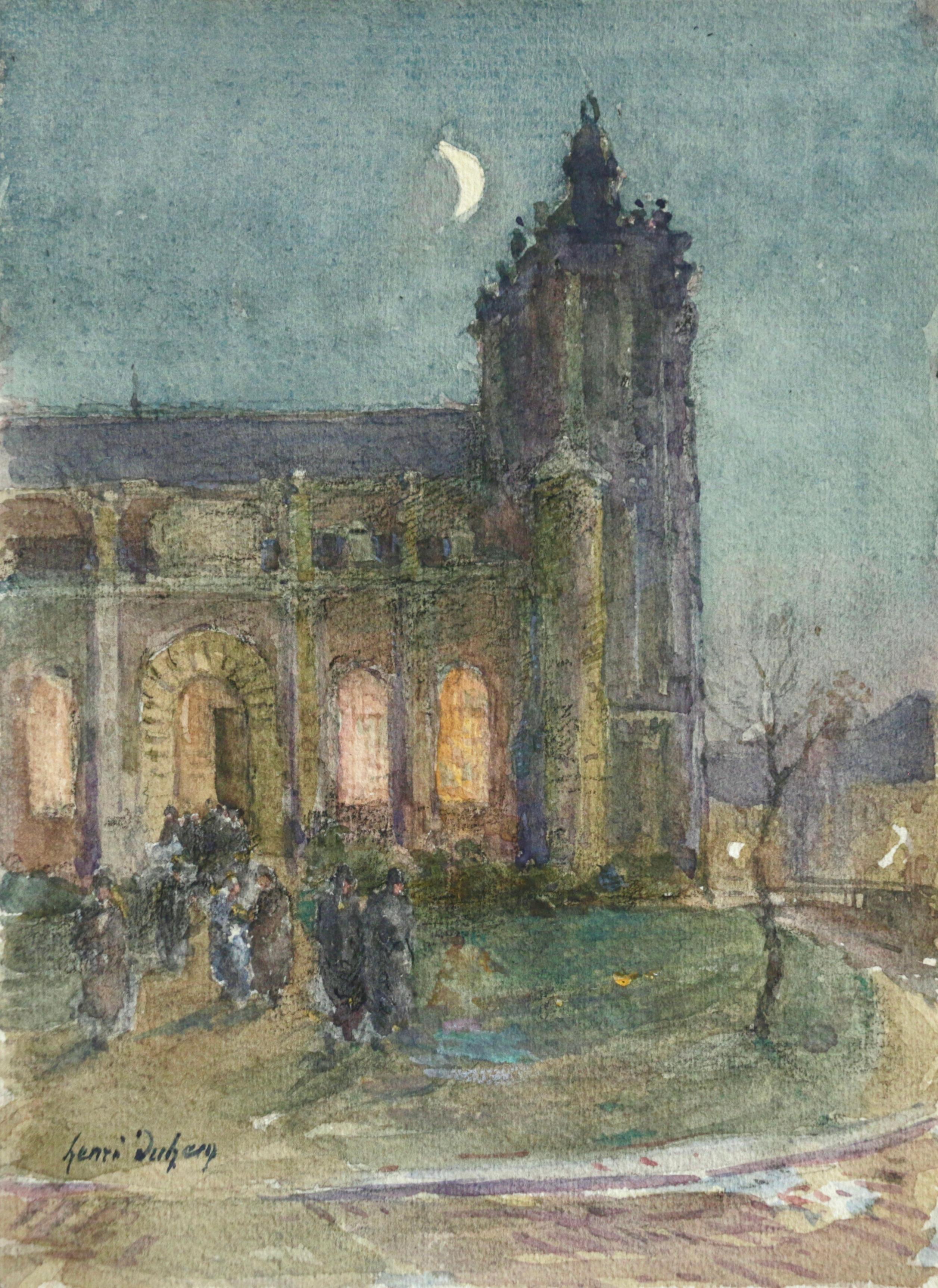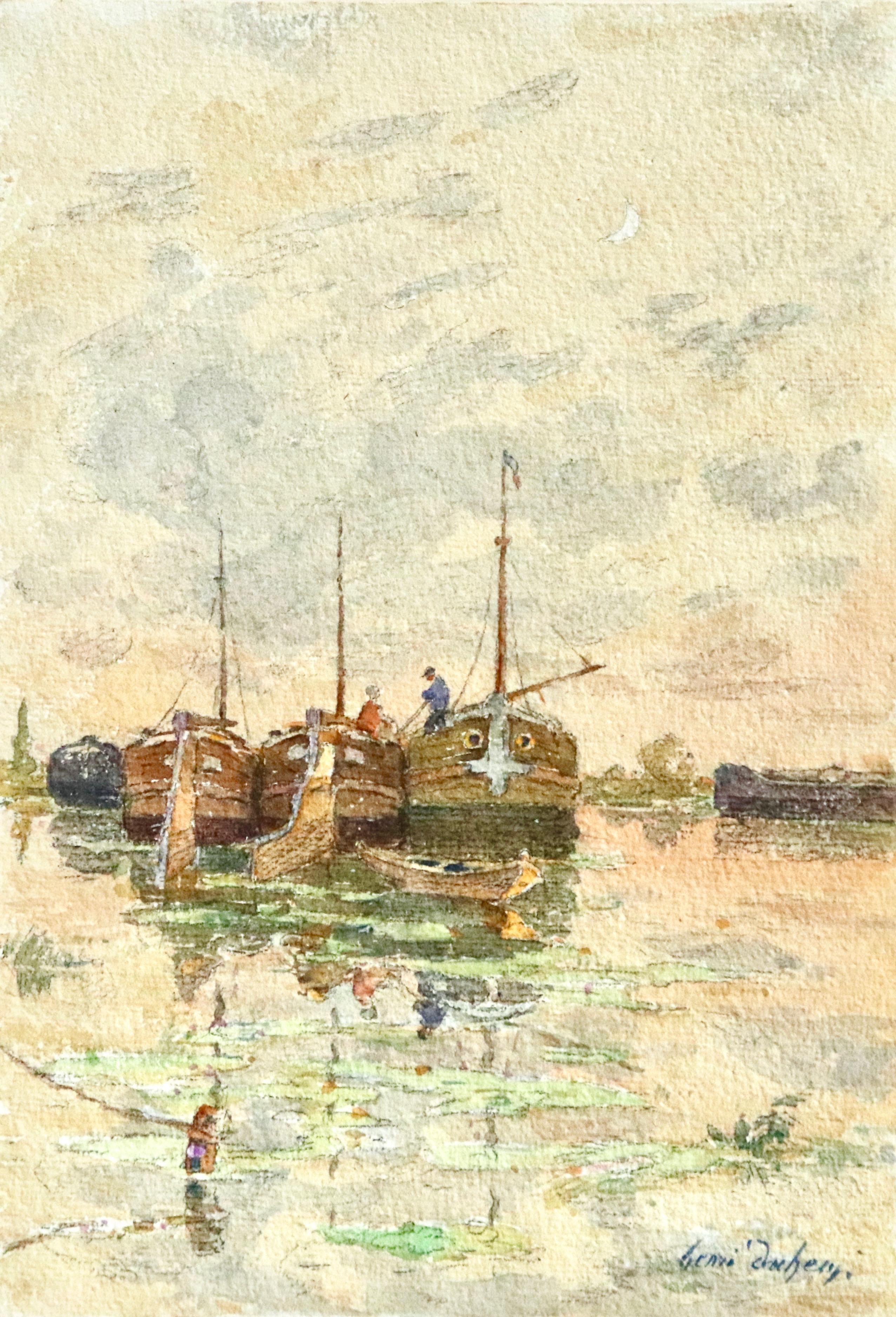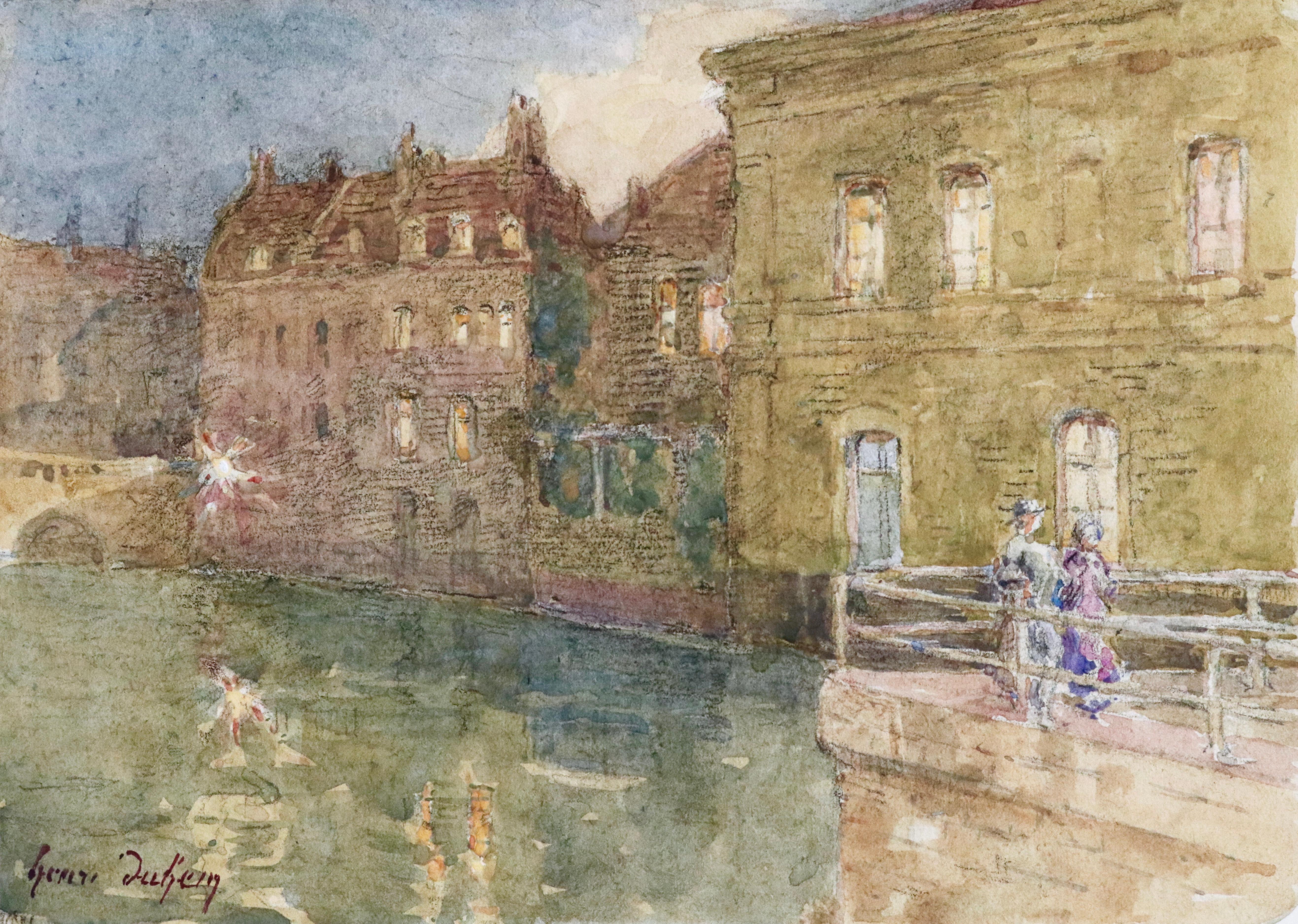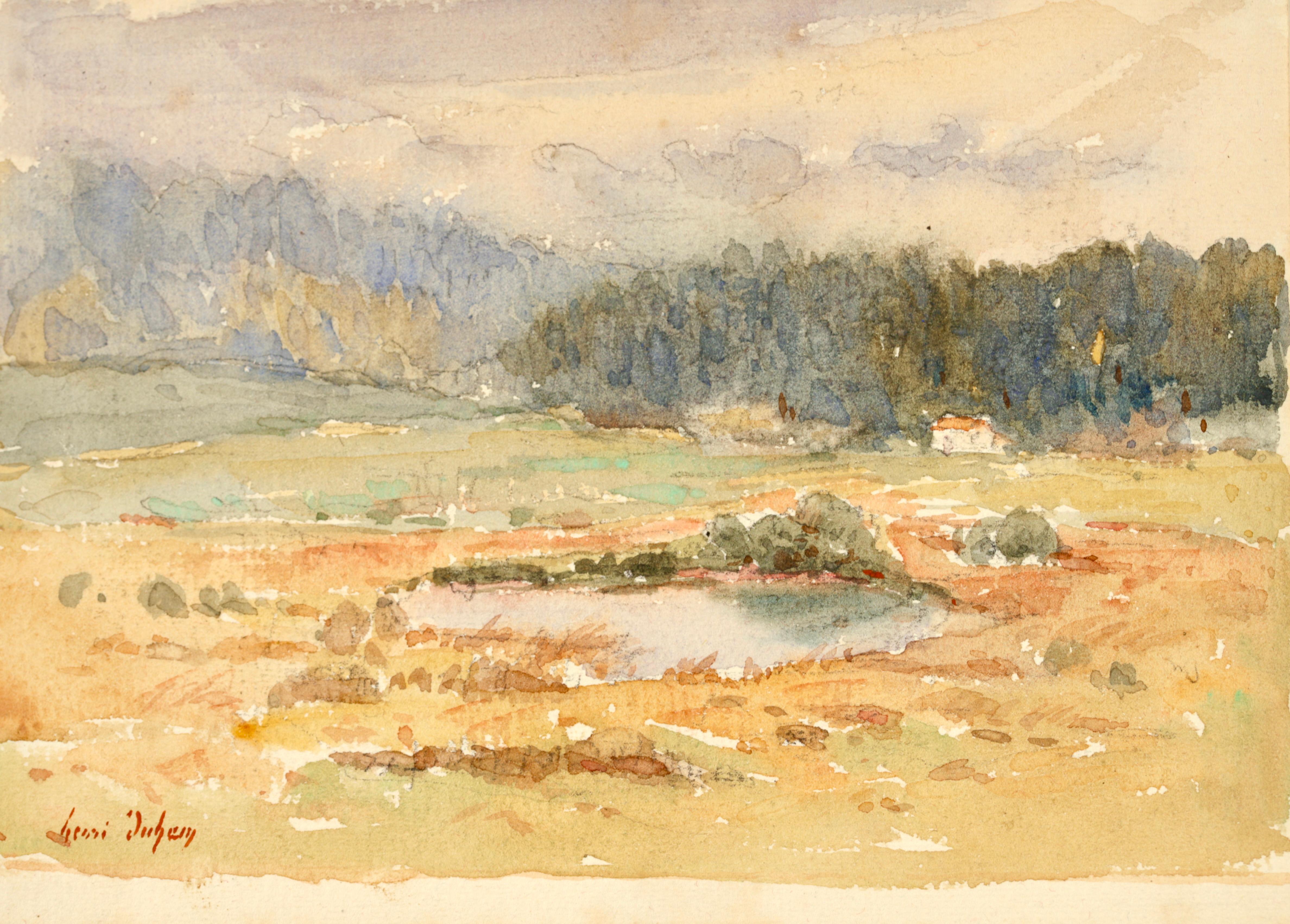Items Similar to Sur la plage de Deauville - Impressionist Figurative Watercolor by Eugene Boudin
Want more images or videos?
Request additional images or videos from the seller
1 of 18
Eugène Louis BoudinSur la plage de Deauville - Impressionist Figurative Watercolor by Eugene Boudinc.1865
c.1865
About the Item
Signed watercolour on paper landscape circa 1865 by French impressionist painter Eugene Boudin. This work depicts an artist painting a portrait of an elegant couple on the beach at Deauville. The couple pose on the beach as they are being painted by an artists seated on a stool in front of them. The subject of the elegant couple is depicted in numerous scenes by Boudin - often entitled "Crinolines" - which referenced the large hooped dresses that the women of the period would wear.
Signature:
Stamped lower right with the atelier stamp E.B. (Lugt 828)
Dimensions:
Framed: 12.5"x17.5"
Unframed: 6.5"x11.5"
Provenance:
Christie's London c. 1920 (stencil verso)
Beaux Arts Gallery London c. 1930 (labels verso)
Pearson & Westergaard - Glasgow c. 1940 (labels verso)
The son of a mariner, Eugène Boudin initially considered becoming a marine pilot. However, a year after his family settled in Le Havre, in 1835, he began work as an apprentice at a printing/publishing house, then in a stationery firm, where he stayed until he was 18 before setting himself up in the same business. Passionate about drawing and painting, he was given encouragement and advice by the painters Millet, Isabey, Couture, Troyon and Masurier, whose pictures he exhibited in his shop windows. In 1846 he left his shop, devoting himself fully to art. Several changes of fortune then followed. First, in 1847, he moved to Paris, where he spent many hours in the Louvre. Secondly, the desire to escape the upheavals of the 1848 Revolution forced him to travel throughout northern France and Belgium, giving him the opportunity to study the Old Flemish masters. In 1851, Le Havre Municipal Council awarded him a three-year scholarship, which he spent in Paris and, primarily, in Honfleur. Many years of patient effort, application and hard work ensued, documented in numerous sketches and drawings conscientiously depicting his travels and his thoughts. From the outset, Boudin's work is marked by his desire to paint the actual scene before his eyes, and not to impose imaginative elements; thus, he attempts to translate the ever-changing spectacle of the skies and clouds racing over the sea directly into pastel, watercolour or oil. In 1855, he made his first trip to Brittany, to the Finistère area, where he was often to return during his lifetime. His subjects there included the indoor and outdoor markets, festivals, people leaving mass and the Breton pardons or religious festivals, as well as the wild, rocky coasts, characterized by far darker hues and more threatening skies than the coastline of his native Normandy. In 1858, he made the acquaintance of Claude Monet, who was staying at Le Havre. Boudin gave Monet a taste for painting en plein air, and continued to be associated with him for the rest of his life. In 1859, he met Courbet and Baudelaire, the latter of whom was the first to acknowledge his talent, in Salon of 1859. Around 1860, Boudin decided to settle permanently in Paris. He worked for Troyon, preparing the skies in his compositions, and was acquainted with Corot, Daubigny and later Jongkind, whom he particularly admired. During the Franco-Prussian War of 1870-1871 he fled to Belgium, where he produced many fine paintings, notably in Antwerp in 1871 and 1872. On his return to Trouville in September 1871, his works sold readily. He worked until his strength was exhausted, painting his last picture in Beaulieu in 1898. In May, he was taken back to Paris, then to Deauville, where he died by the sea on 8 August 1898.
Boudin first exhibited in Paris in 1857, at the Concert Musard, at the age of 35, with Alexandre Dumas purchasing two works. In 1859, he made his Salon debut, going on to exhibit regularly there until 1897. In 1874, he took part with Nadar in the first Impressionist Exhibition in Paris, and his reputation was firmly established from then on. From 1881, the art dealer Durand-Ruel bought the majority of his works and regularly organised exhibitions. In addition to the pictures that Boudin sent to the Salons, his works were included in many other exhibitions, of which only those organised by Durand-Ruel are cited here - 1883: 150 paintings; 1889: 89 paintings; 1891: 33 paintings, 35 pastels, 190 drawings; 1898 (in New York): 49 paintings; 1903 (New York): 39 paintings; 1923: 66 paintings; 1927: 44 paintings; 1929 (New York): 33 paintings; 1933 (New York): 30 paintings; 1936: 20 paintings. Following his death, a retrospective exhibition of his works was organised at the Paris École des Beaux-Arts in 1899, which included 364 paintings, 73 pastels and 20 watercolours. After almost a century without a retrospective exhibition of his work, the town of Honfleur paid a great tribute to him in 1992. Boudin had not seen many such acknowledgements during his life. In 1881, he was awarded, for the first time, a third-class medal at the Salon, subsequently receiving a gold medal at the 1889 Exposition Universelle. He was finally made a Chevalier of the Légion d'Honneur in October 1892.
From 1862, and on the advice of Isabey, who had been Boudin's tutor (though other sources state it was at Baudelaire's instigation) he painted elegant women on the fashionable beaches, especially Trouville, which could be reached by rail. These motley crowds were often depicted by touches of colour which, starting from vague shapes, could develop into the clear form of the fashionable lady of the Second Empire or the dandy. With regard to his 'high society' models, in contrast to Millet's social preoccupations or Courbet's political concerns, it is intriguing to read Boudin's contemporary opinion of the artist's role in society. In 1861, he wrote to a friend: 'Peasants have their painters. That's good. But, between you and me, these middle-class people who stroll along the jetty into the sunset, are they not also entitled to be captured on canvas, to be led towards the light? Between ourselves, they often work extremely hard, these people who step out from their offices and their studies. If among them there are a few parasites, are there not also people who do their job properly?' It is obvious that the question bothers him. Even if he only formulates it in terms of certain people's right to be used as models by the artist, the question signals a deeper concern with the place of art and the artist in bourgeois society, which tends to spurn artists as innovators, and thus implicitly as revolutionaries. In common with many artists of the 19th and 20th centuries, Boudin resolves the matter by separating the aesthetic from the moral. He no longer considers the social status of his models, but concentrates solely on their external appearance. Thus, in another passage he concludes: 'One experiences a certain shame when painting idle laziness. It is fortunate that the Creator has scattered a little of his splendid and warming light everywhere; it is the world that is enveloped by this light that we painters reproduce'. The key term here for Boudin is 'light' - it is apparent that the actual objects he paints hold little interest for him in themselves; far more important is the beautiful play of light on those objects.
Throughout his life, as soon as spring arrived, Boudin could be found setting up his easel on the open coast, or on quaysides, painting seascapes with three-masters and fishing boats. In 1874, he stayed for a long spell in Bordeaux. He continued to be prolific, travelling almost every year to the beaches of northern France, returning to Trouville, to the banks of the River Touques, where he liked to paint the washerwomen, to Honfleur, and to Le Havre. Although he twice travelled to Villefranche, in 1882 and 1887, it was not until 1890 that he painted extensively there, staying in the Midi region each winter for longer and longer periods, and moving on as far as Venice in 1892 and 1895. The period during which he painted the cliffs of Étretat on the Normandy coast with increasingly thick brushstrokes (perhaps under Monet's influence), was followed by a period of grey and mother-of-pearl tonalities.
Eugène Boudin's work is not only important in its own right and for what it reveals about the artist, it is also highly significant (despite Boudin's own sense of modesty) for the historical part it plays in the development of painting - in particular, the beginnings of 'open-airism' and the birth of Impressionism. The Impressionists recognised Boudin as one of their forerunners by inviting him to join their group in 1875, and Monet paid him no small tribute by stating that if he had become a painter, he owed it to Boudin. It is also useful to recall a few dates to highlight Boudin's historical importance, which is inseparable from the roughly similar role played by Jongkind, who, although very different in character, showed great kinship with Boudin in painting sur le motif. Constable died in 1837, Bonington's short life ran from 1801 to 1828 and Turner died in 1851. Delacroix, who took his place among the forerunners of Impressionism only by virtue of the profound influence English landscape artists exerted on his work, died in 1863, while there is no doubt that Corot and the painters of the Barbizon School expressed a new feeling for nature. All these artists began to work outside, but all the works they prepared or sketched in the open air 'go back through the studio again', in Corot's words. Still a long way from recognising and trying to convey the essential fluidity of nature, which the Impressionists made into a dogma, these earlier artists therefore had no conception that a painting did not have to be ‘composed’ or ‘finished’ - a task that could only be completed in the calm surroundings of the studio. Even so, in their initial studies, their more direct contact with nature and especially with real sunlight, diffuse and no longer governed by the 'lighting' of a studio, helps lighten their palette and bathe the whole canvas in light. These artists are thus led to think in advance about the actual nature of light and its unexplored pictorial possibilities. Courbet painted Young Women on the Banks of the Seine in 1856, Manet painted Concert in the Tuileries Gardens around 1860, The Picnic ( Le Déjeuner sur l'Herbe) in 1863, Races at Longchamp, Paris in 1864, Degas painted Gentlemen's Race, Before the Start in 1862. The phrase 'before the start' is revealing. It no longer indicates a precise moment in the past, but all the sensations that characterise a moment of real time that has been experienced, almost an 'impression'. These works are still composed according to a set formula of combination; in other words, the landscape is painted outdoors and the figures are added in the studio, the people seem to be posed on the backgrounds and are still painted using the technique of local colour. The landscape, which is separate from the figures, and which is recomposed in accordance with classical antecedents, remains constrained, The Picnic ( Le Déjeuner sur l'Herbe) being a very typical example of this. It was not until 1867 that Monet painted his Women in the Garden fully en plein air, with both landscape and figures observed outside. It would not be long before new scientific discoveries on the composition of light and Chevreul's pioneering work on colour theory would fundementally change artists' attitude to nature and bring Impressionism to its peak.
However, in advance of Impressionism, yet with no inkling of their historical significance, Jongkind and Boudin had already resolved in practice many of the movement's abiding concerns - namely, how to grasp the colour and flavour of a fleeting instant, how to capture the transparency of the atmosphere and its distance, and how to integrate figures naturally into the landscape. This they achieved simply by painting exclusively outdoors, and by painting only what they really observed outdoors, as they saw it. The Le Havre painter Charles Lhullier, who knew Boudin and Jongkind and painted with them on the Normandy coasts, gaining from them an understanding of how colours interrelate in and by means of the precision and unity of the light, was able to pass on this sense of light, so typical of the French School from the time of Poussin and Claude Lorraine, to his students at the École des Beaux-Arts in Le Havre, students such as Dufy, Friesz and Braque. This sense of the accuracy and unity of light, inherited from Boudin, would also go on to influence Fauvism and so to differentiate it fundamentally from the work of the central European Expressionists, who employed unnatural colours principally for their shock value.
Museum and Gallery Holdings:
Agen: Russian Corvette in the Eure Docks
Alençon: Rocks of Antibes (1893); Cattle in the Marsh (acquired in 1894)
Algiers: Port of Trouville
Baltimore (Walters AM)
Bayonne (Mus. Bonnat): Beach; Boat at Low Tide; Low Tide at Étaples (1890, gift of Baron Rothschild)
Boulogne-sur-Mer: Port of Le Havre; Port of Le Havre; Environs of Trouville; Sunset; Étaples; Regatta; Touques Old Port; Ruins of Larsay Castle; Juan-les-Pins
Caen: Tourgeville Beach (1893); Cattle in a Meadow (1874, gift of M. Jacquette)
Cambrai: Trouville Port at Low Tide
Dallas (MA): The Quay at Antwerp (1874, oil on panel)
Dieppe: Port of Dieppe (sketch, gift of M. G. Cahen)
Dijon: Port of Trouville; Port of Honfleur; Cow in Meadow
Edinburgh (Nat. Gal. of Scotland): The Port of Bordeaux (1874, oil on canvas)
Honfleur: Dusk (gift of M. Alexandre Dubourg); Portrait of the Artist's Father; Still-life (Fish); Still-life (Fish); Still-life (Game); Still-life (Leg of Lamb); Study of Horse; On the Beach; On the Beach (Portrait); On the Beach (Family Meal); Still-life (Game); Mme Pécrus in her Garden; Village of Fesvaques; Study in Antwerp; Landscape with Figures; View of Trouville; View of Trouville; Landscape; Berck Fisherwoman; Normandy Woman; Portrait of a Young Girl; Portrait; Flemish School Copy (Game); Flemish School Copy (Game); The Embarkation for Cythera (copy, after Boucher); Woman with Goat (after Boucher)
Johannesburg: Regatta; Jetty at Trouville; Port of Trouville (gift of Otto Beit)
Le Havre: Still-life; Pardon of Ste-Anne-la-Palud (1858); Still-life (Fish); Venice (1897); Jetty at Le Havre; Deauville Docks (1887); Entrance to the Port of Honfleur; Study (Livestock); River Touques (three canvases, gift of M. Louis Boudin); Caudebac (1889)
Liège: View of Deauville Docks, Grey Sky; Trouville Market Place; Fishing Boat Lying High and Dry at Trouville Port
Lille (MBA): Camaret Harbour during a Storm (1873, oil on canvas)
London (NG): Beach Scene, Trouville (c. 1860-1870, c. 1870-1874, 1873, oil/wood, three versions); The Entrance to Trouville Harbour (1888, oil/wood, on loan at the York Art Gallery); The Beach at Tourgéville-les-Sablons (1893, oil on canvas, on loan to the Hugh Lane Municipal Gallery of Modern Art in Dublin since 1979); Beach at Trouville ('A Squall from the West') (1890's, sketch)
Lyons: View of Trouville
Manchester: Étaples (1888, acquired in 1908)
Morlaix: Boat Lying High and Dry; Squall
Nantes (MBA): Port of Dordrecht (Port de Dordrecht)
Paris (Louvre): Trouville Beach; Bordeaux; Bathers on Trouville Beach; Deauville Jetty; Sailing Ships; Beach; Russian Corvette (1888); Villefranche Harbour (1892); Port of Bordeaux (1874)
Paris (Louvre, Prints Collection): Bequest of over 6,000 sketches, pastels and watercolours
Pau: Seascape; Bordeaux (1874); View of Antwerp (1871, gift of M. P. Lalandes); Town Hall, City Walls and Francis I Tower (1852); Francis I Tower (1852, gift of Mme Martin); Stream (copy, after Ruysdael); Meadow and Still-life (copy, after P. Petter)
Pau (MBA): View of Antwerp (1871)
Portland, ME (MA): Camaret Harbor (or Port at Camaret) (c. 1871)
Rennes (MBA): Trouville
Rheims: Landscape; Breton Farm; Port at Bordeaux, Bacalan Quay; Port of Bordeaux, Quai des Chartrons; Berck; Trouville; Rising Tide; Livestock; Boats Leaving; Return of the Boats; Corner of a Farm; Three Views of Venice; River Touques, Morning
Rotterdam: Spanish Quayside in Rotterdam (1876, gift of M. van der Velde, 1910)
Rouen: Fisherman
St-Lô: Sunset; Low Tide (1884)
Stockholm (Nationalmus.): Fishing Boats at Fécamp
Strasbourg: Landscape
Valenciennes: Basse Docks at Le Havre (1887, gift of the journal 'l'Art', 1888
- Creator:Eugène Louis Boudin (1824-1898, French)
- Creation Year:c.1865
- Dimensions:Height: 12.5 in (31.75 cm)Width: 17.5 in (44.45 cm)
- More Editions & Sizes:6.5"x11.5" unframedPrice: $31,869
- Medium:
- Movement & Style:
- Period:
- Condition:Very good original condition.
- Gallery Location:Marlow, GB
- Reference Number:
About the Seller
5.0
Platinum Seller
These expertly vetted sellers are 1stDibs' most experienced sellers and are rated highest by our customers.
Established in 2001
1stDibs seller since 2016
669 sales on 1stDibs
Typical response time: 3 hours
- ShippingRetrieving quote...Ships From: Marlow, United Kingdom
- Return PolicyA return for this item may be initiated within 3 days of delivery.
More From This SellerView All
- L'église de nuit - Impressionist Watercolor, Figures in Landscape by Henri DuhemBy Henri DuhemLocated in Marlow, BuckinghamshireSigned impressionist watercolour on paper circa 1910 by French painter Henri Duhem. The piece depicts churchgoers leaving mass walking into the cold night. The crescent moon shines b...Category
1910s Impressionist Figurative Drawings and Watercolors
MaterialsPaper, Watercolor
- On the Barges - 19th Century Watercolor, Figures on Boats on River - Henri DuhemBy Henri DuhemLocated in Marlow, BuckinghamshireWatercolour on paper circa 1910 by Henri Duhem depicting figures on boats on the river, their reflections visible in the water below and a crescent moon in the sky. Signed lower righ...Category
Early 20th Century Impressionist Landscape Drawings and Watercolors
MaterialsWatercolor, Paper
- Canal - Evening - 19th Century Watercolor, Elegant Figures by Water by H DuhemBy Henri DuhemLocated in Marlow, BuckinghamshireWatercolour on paper circa 1905 by Henri Duhem depicting an elegant couple enjoying an evening stroll by the canal. Signed lower left. This painting is not currently framed but a sui...Category
Early 20th Century Impressionist Figurative Drawings and Watercolors
MaterialsPaper, Watercolor
- Mont Riant 1925 - French Impressionist Watercolor, Landscape by Henri DuhemBy Henri DuhemLocated in Marlow, BuckinghamshireSigned, dated and titled impressionist landscape watercolour on paper by Henri Duhem. This beautiful piece depicts a view of a pond with a house on the edge of dense forest behind. T...Category
1920s Impressionist Landscape Drawings and Watercolors
MaterialsPaper, Watercolor
- The Boathouse - Impressionist Watercolor, Figure in Landscape by Henri DuhemBy Henri DuhemLocated in Marlow, BuckinghamshireSigned impressionist figure in landscape watercolour on paper circa 1920 by Henri Duhem. This beautiful work depicts a view of a lake with banks of green trees beside it and blue mou...Category
1920s Impressionist Landscape Drawings and Watercolors
MaterialsPaper, Watercolor
- Sur la riviere - Impressionist Watercolor, Figure in Landscape by Henri DuhemBy Henri DuhemLocated in Marlow, BuckinghamshireSigned impressionist landscape watercolour on paper circa 1920 by Henri Duhem. The piece depicts a figure walking along a path beside a boat moored on the river side. The sun is sett...Category
1920s Impressionist Landscape Drawings and Watercolors
MaterialsPaper, Watercolor
You May Also Like
- Devotion in the Dessert near the pyramids of Gizeh, circa 1919By Marius BauerLocated in Amsterdam, NLMarius Bauer (1867-1932) ‘Devotie in de Woestijn’ (Devotion in the Dessert near the pyramids of Gizeh, circa 1919) Signed lower right and titled lower left Watercolour on paper, H...Category
Early 20th Century Impressionist Landscape Drawings and Watercolors
MaterialsPaper, Ink, Watercolor, Pencil
- "Untitled 1, " Watercolor PaintingLocated in Denver, COClyde Steadman's "Untitled 1" is an original, handmade watercolor painting that depicts an urban landscape with human silhouettes.Category
2010s American Impressionist Figurative Drawings and Watercolors
MaterialsPaper, Watercolor
- Horse in the Fields - 1930's Watercolor Figurative LandscapeBy John StellmanLocated in Soquel, CAHorse in the fields, a figurative watercolor landscape by Louis John Stellman (American, 1877-1961), c.1935. Presented in a wooden frame with linen liner. Signed "Stellman" lower right. Image size, 15"H x 19"W. Stellman moved to CA in 1901. By 1920 he had settled in San Francisco where he worked both as an artist and a writer for the Call-Bulletin newspaper. He later moved to the Monterey Peninsula where he remained until his death. Married to artist Edith K. Stellman (1877-1957). Works held: de Young Legion of Honor. His books include: Mate o'dreams and Other Poems Mother Lode; The Story of California's Gold Rush Port O' Gold A History-Romance of the San Francisco Argonauts Said the Observer Sam Brannan, Builder of San Francisco; A Biography That Was a Dream Worth Building; the Spirit of San Francisco's Great Fair Portrayed in Pictures and Words The Vanished Ruin Eta; San Francisco's Classic Artistry of Ruin Depicted in Picture and Song Stellmann was a protegé of Arnold Genthe...Category
1930s American Impressionist Landscape Drawings and Watercolors
MaterialsPaper, Watercolor
- Mount Washington Farmhouse, Watercolor Landscape with BarnLocated in Soquel, CAScenic countryside landscape of a barn and cows in front of Mount Washington by Mark Henthorn (American, 1943-2018), 1980. Signed and dated "Henthorn '80" lower left. Displayed in rustic wood frame. Image size, 12"H x 16"L. Mark Henthorn was an American painter with a love of nature and strong respect for light. His work depicts a mood of peace and serenity seen in the spaciousness of the Western landscape. He spent over thirty years as an award-winning architect and illustrator. His art has been displayed in galleries in Idaho, Montana, Colorado, and in the Port Townsend...Category
1980s American Impressionist Landscape Drawings and Watercolors
MaterialsWatercolor, Paper
- Fishing Boats at Shore, 1940's Seascape WatercolorLocated in Soquel, CABeautiful mid-century small-scale watercolor landscape of fishermen with their boats on the shore by unknown artist. Signed lower left corner illegibly. Circa 1940's. Unframed. Image...Category
1940s American Impressionist Landscape Drawings and Watercolors
MaterialsPaper, Watercolor
- Mid Century Country House LandscapeBy Rene WeaverLocated in Soquel, CAVivid watercolor of a country house and grove of trees in a rural landscape of rolling green hills, with farm animals in the distance, by California artist Rene Weaver (American, 189...Category
1940s American Impressionist Landscape Drawings and Watercolors
MaterialsPaper, Watercolor
Recently Viewed
View AllMore Ways To Browse
Open Window View Painting
Period Fauvism Painting
Monet Framed Prints Claude Monet
Watercolors Of The French Quarter
Spying Eye Painting
Sugar Devil
Charlotte Barnes Any
Grand Tableau Rouge
Jimmy Chin
Michel Parmentier
Martini Glass Painting
Alexander Hardy
Bw Nude
Japanese Rig
Nestan Mikeladze
Vintage Silver Gelatin Apollo Photo
Visionnaire Books
Corkscrew Painting
